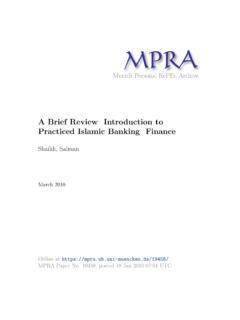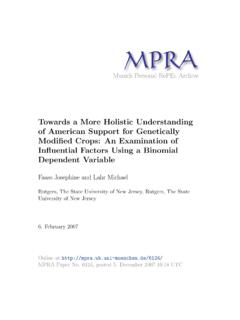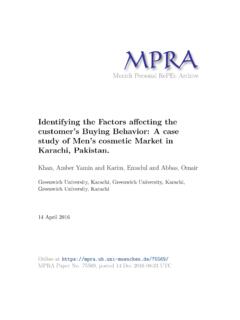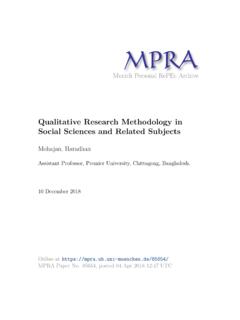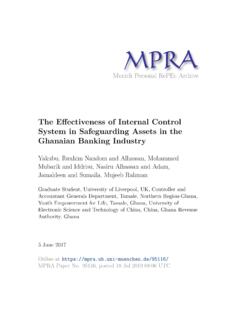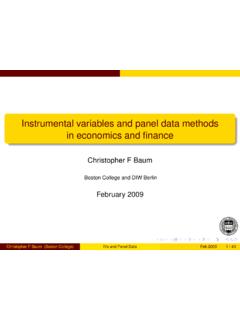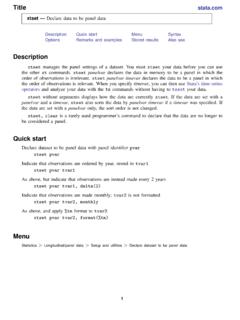Transcription of Panel Data Analysis with Stata Part 1 - LMU
1 Munich Personal RePEc ArchivePanel data Analysis with Stata Part 1 Fixed Effects and Random EffectsModelsPillai N., Vijayamohanan2016 Online Paper No. 76869, posted 20 Feb 2017 09:51 UTC Panel data Analysis with Stata Part 1 Fixed Effects and Random Effects Models Vijayamohanan Pillai N. Centre for Development Studies, Kerala, India. e-mail; 2 Panel data Analysis with Stata Part 1 Fixed Effects and Random Effects Models Abstract The present work is a part of a larger study on Panel data . Panel data or longitudinal data (the older terminology) refers to a data set containing observations on multiple phenomena over multiple time periods. Thus it has two dimensions: spatial (cross-sectional) and temporal (time series). The main advantage of Panel data comes from its solution to the difficulties involved in interpreting the partial regression coefficients in the framework of a cross-section only or time series only multiple regression.
2 Depending upon the assumptions about the error components of the Panel data model, whether they are fixed or random, we have two types of models, fixed effects and random effects. In this paper we explain these models with regression results using a part of a data set from a famous study on investment theory by Yehuda Grunfeld (1958), who tried to analyse the effect of the (previous period) real value of the firm and the (previous period) real capital stock on real gross investment. We consider mainly three types of Panel data analytic models: (1) constant coefficients (pooled regression) models, (2) fixed effects models, and (3) random effects models. The fixed effects model is discussed under two assumptions: (1) heterogeneous intercepts and homogeneous slope, and (2) heterogeneous intercepts and slopes. We discuss all the relevant statistical tests in the context of all these models.
3 3 Panel data Analysis with Stata Part 1 Fixed Effects and Random Effects Models Panel data Analysis : A Brief History According to Marc Nerlove (2002), the fixed effects model of Panel data techniques originated from the least squares methods in the astronomical work of Gauss (1809) and Legendre (1805) and the random effects or variance-components models, with an English astronomer George Biddell Airy, who published a monograph in 1861, in which he made explicit use of a variance components model for the Analysis of astronomical Panel data . The next stage is connected to R. A. Fisher, who coined the terms and developed the methods of variance and Analysis of variance (Anova) in 1918; he elaborated both fixed effects and random effects models in Chapter 7: Interclass Correlations and the Analysis of Variance and in Chapter 8: Further applications of the Analysis of Variance of his 1925 work Statistical Methods for Research Workers.
4 However, he was not much clear on the distinction between these two models. That had to wait till 1947, when Churchill Eisenhart came out with his Survey that made clear the distinction between fixed effects and random effects models for the Analysis of non-experimental versus experimental data . The random effects, mixed, and variance-components models in fact posed considerable computational problems for the statisticians. In 1953, CR Henderson developed the method-of-moments techniques for analysing random effects and mixed models; and in 1967, HO Hartley and JNK Rao devised the maximum likelihood (ML) methods for variance components models. The dynamic Panel models started with the famous Balestra-Nerlove (1966) models. Panel data Analysis grew into its maturity with the first conference on Panel data econometrics in August 1977 in Paris, organized by Pascal Mazodier.
5 Since then, the field has witnessed ever-expanding activities in both methodological and applied research. Panel data or longitudinal data (the older terminology) refer to a data set containing observations on multiple phenomena over multiple time periods. Thus it has two dimensions: spatial (cross-sectional) and temporal (time series). In general, we can have two panels : micro and macro panels surveying (usually a large) sample of individuals or households or firms or industries over (usually a short) period of time yields micro panels , whereas macro panels consist of (usually a large) number of countries or regions over (usually a large) number of years. 4 Nomenclature A cross sectional variable is denoted by xi, where i is a given case (household or industry or nation; i = 1, 2, .., N), and a time series variable by xt, where t is a given time point (t = 1, 2.)
6 , T). Hence a Panel variable can be written as xit, for a given case at a particular time. A typical Panel data set is given in Table 1 below, which describes the personal disposable income (PDY) and personal expenditure in three countries, Utopia, Lilliput and Troy over a period of time from 1990 2015. Table 1: A Typical Panel data Set CCoouunnttrryy YYeeaarr PPDDYY PPEE UUttooppiiaa 11999900 66550000 55000000 UUttooppiiaa 11999911 77000000 66000000 .. UUttooppiiaa 22001155 1155000000 1111000000 LLiilllliippuutt 11999900 11550000 11330000 LLiilllliippuutt 11999911 11770000 11660000 .. LLiilllliippuutt 22001155 55445500 55000000 TTrrooyy 11999900 22220000 11880000 TTrrooyy 11999911 22440000 22000000 .. TTrrooyy 22001155 88550000 77550000 Depending upon the configuration of space and time relative to each other, panels can take two forms: in the first case, time is nested or stacked within the cross-section and in the second, cross-section is nested/stacked within time, as Table 2 below shows: 5 Table 2: Two Forms of Panel Configuration TTiimmee nneesstteedd wwiitthhiinn tthhee ccrroossss--sseeccttiioonn ccrroossss--sseeccttiioonn nneesstteedd wwiitthhiinn ttiimmee CCoouunnttrryy YYeeaarr YYeeaarr CCoouunnttrryy UUttooppiiaa 11999900 11999900 UUttooppiiaa UUttooppiiaa 11999911 11999900 LLiilllliippuutt.
7 11999900 TTrrooyy .. 11999911 UUttooppiiaa UUttooppiiaa 22001155 11999911 LLiilllliippuutt LLiilllliippuutt 11999900 11999911 TTrrooyy LLiilllliippuutt 11999911 11999922 UUttooppiiaa .. LLiilllliippuutt 22001155 .. TTrrooyy 11999900 .. TTrrooyy 11999911 .. 22001155 UUttooppiiaa .. 22001155 LLiilllliippuutt TTrrooyy 22001155 22001155 TTrrooyy Again, depending upon whether the panels include missing values or not, we can have two varieties: balanced and unbalanced Panel . Balanced Panel does not have any no missing values, whereas the unbalanced one has, as Table 3 illustrates; 6 Table 3: Balanced and Unbalanced Panel BBaallaanncceedd ppaanneell UUnnbbaallaanncceedd PPaanneell PPeerrssoonn SSll NNoo YYeeaarr IInnccoommee AAggee SSeexx PPeerrssoonn SSll NNoo YYeeaarr IInnccoommee AAggee SSeexx 11 22000044 880000 4455 11 11 22000055 11775500 3322 11 11 22000055 990000 4466 11 11 22000066 22550000 3333 11 11 22000066 11000000 4477 11 22 22000044 22000000 4400 22 22 22000044 11550000 2299 22 22 22000055 22550000 4411 22 22 22000055 22000000 3300 22 22 22000066 22880000 4422 22 22 22000066 22550000 3311 22 33 22000066 22550000 2288 22 We have two more models, depending upon the relative size of space and time, short and long panels .
8 In a short Panel , the number of time periods (T) is less than the number of cross section units (N), and in a long Panel , T > N. Note that Table 1 above gives a long Panel . Advantages of Panel data Hsiao (2014) Baltagi (2008) and Andre et al. (2013) list a number of advantages of using Panel data , instead of pure cross-section or pure time series data . The obvious benefit is in terms of obtaining a large sample, giving more degrees of freedom, more variability, more information and less multicollinearity among the variables. A Panel has the advantage of having N cross-section and T time series observations, thus contributing a total of NT observations. Another advantage comes with a possibility of controlling for individual or time heterogeneity, which the pure cross-section or pure time series data cannot afford. Panel data also opens up a scope for dynamic Analysis . The main advantage of Panel data comes from its solution to the difficulties involved in interpreting the regression coefficients in the framework of a cross-section only or time series only regeression, as we explain below.
9 Regression Analysis : Some Basics Let us consider the following cross-sectional multiple regression with two explanatory variables, X1 and X2: Yi = + 1X1i + 2X2i + ui ; i = 1, 2, .., N.. (1) 7 Note that X1 is said to be the covariate with respect to X2 and vice versa. Covariates act as controlling factors for the variable under consideration. In the presence of the control variables, the regression coefficients s are partial regression coefficients. Thus, 1 represents the marginal effect of X1 on Y, keeping all other variables, here X2, constant. The latter part, that is, keeping X2 constant, means the marginal effect of X1 on Y is obtained after removing the linear effect of X2 from both X1 and Y. A similar explanation goes for 2 also. Thus multiple regression facilitates to obtain the pure marginal effects by including all the relevant covariates and thus controlling for their heterogeneity. This we ll discuss in a little detail below.
10 We begin with the concept of partial correlation coefficient. Suppose we have three variables, X1, X2 and X3. The simple correlation coefficient r12 gives the degree of correlation between X1 and X2. It is possible that X3 may have an influence on both X1 and X2. Hence a question comes up: Is an observed correlation between X1 and X2 merely due to the influence of X3 on both? That is, is the correlation merely due to the common influence of X3? Or, is there a net correlation between X1 and X2, over and above the correlation due to the common influence of X3? It is this net correlation between X1 and X2 that the partial correlation coefficient captures after removing the influence of X3 from each, and then estimating the correlation between the unexplained residuals that remain. To prove this, we define the following: Coefficients of correlation between X1 and X2, X1 and X3, and X2 and X3 are given by r12, r13, and r23 respectively, defined as = = , = = and = =.
